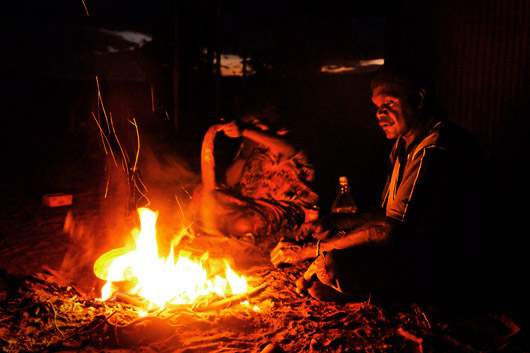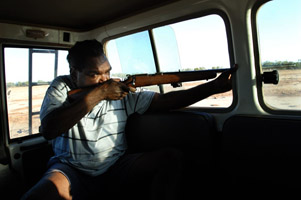A.bc
In Australia, sulle tracce di Chatwin 20 anni dopo Le Vie dei Canti
Palazzo delle Esposizioni, Roma
A.bc
In Australia, in Chatwin's footsteps 20 years after The Songlines Palazzo
Delle Esposizioni, Rome


C’è il cuore urbano con la sua vita da non luogo contemporaneo
(grandi magazzini, fast-food, banche, souvenir). E, intorno, chi preme
ai margini della città. A volte Alice Springs dà l’impressione
di non avere periferia; oltre il fiume secco, è subito bush. Altre
volte sembra averne molte, dalle town camp misere e dimesse ai quartieri
residenziali di case basse con giardini, garage e canestro. Una sera,
a 200 metri da un grande albergo, brilla qualcosa nel buio a lato del
letto del fiume. Attorno a un fuoco tre persone preparano la loro cena,
un canguro cacciato qualche ora prima. Dei 517 mila aborigeni (il 2,5%
della popolazione australiana) la maggioranza vive in aree urbane e circa
il 30% in aree remote, con indicatori sociali critici. Soprattutto nel
Northern Territory dove un terzo della popolazione è aborigena.
La mortalità infantile è dalle tre alle quattro volte superiore
alla media nazionale. La disoccupazione è il triplo di quella della
popolazione non indigena. Più di due aborigeni su tre non hanno
un titolo di studio. Un detenuto su cinque è aborigeno. Secondo
alcuni dati il tasso di omicidi di Alice Springs è 25 volte la
media nazionale. Nelle comunità lontane il tasso di natalità
è tra le quattro e cinque volte quello del paese. Tra dieci anni
vi saranno molti più bambini aborigeni. Sopravvivono, crescono.
Hanno resistito a un tentativo di azzeramento, hanno una sperimentata
capacità di adattamento. All’ambiente, agli eventi. Questa
è la loro terra, da oltre 40 mila anni. “La nostra terra
è viva”, si legge in un manifesto, “la nostra cultura
è forte”. L’incrocio con la storia dei bianchi è
una parentesi di 200 anni. Per chi è venuto da fuori è molto
difficile capire, immaginare quanto sia complessa la loro concezione e
pratica di vita. Il nostro è solo un passaggio nella notte
Una vecchia carabina, una scatola di pallottole e un fuoristrada per spingersi nel bush. Al tramonto, momento migliore per andare a caccia di canguri e tacchini selvatici
Una vecchia carabina, una scatola di pallottole e un fuoristrada per spingersi nel bush. Al tramonto, momento migliore per andare a caccia di canguri e tacchini selvatici
There
is the urban heart, with its ”non-place” contemporary life
(department stores, fast-food, banks, souvenir). And, around it, those
who press against the edge of the city. Sometimes Alice Springs gives
the impression that it has no suburbs; beyond the dry river, there is
immediately the bush. Other times it seems to have many, from poor and
humble town camps to residential neighborhoods with low houses with gardens,
garages and basket. One evening, 200 metres from a five-star hotel, something
shines on the dark side of the riverbed. Around a fire, three people are
cooking a kangaroo hunted some hours before. Of the 517.000 Aboriginal
people (2.5% of the Australian population) the majority lives in urban
areas and about 30% in remote areas, with critical social statistics.
Especially in the Northern Territory where a third of the population is
Aboriginal. Infant mortality is from three to four times higher than the
national average. Unemployment is three times as much as non-indigenous
population. More than two Aboriginal people in three do not have a diploma.
A prisoner in five is Aboriginal. According to some data the rate of murders
of Alice Springs is 25 times higher than the national average. In remote
communities the birth rate is between four and five times that of the
country. In ten years there will be many more Aboriginal children. They
survive, grow. They resisted an attempt of extermination, they have an
experimented capability of adaptation. To the environment, to events.
This has been their land for over 40 thousand years. “Our land is
alive”, you can read on a poster, “our culture is strong".
The crossing with the history of white people is a parenthesis of 200
years. For those who come from abroad it is very difficult to understand,
to imagine how complex their view and experience of life is. Ours is only
a passage into the night
An old rifle, a box of bullets and a jeep to go into the bush. At sunset, the best time to go hunting for kangaroos and wild turkeys
An old rifle, a box of bullets and a jeep to go into the bush. At sunset, the best time to go hunting for kangaroos and wild turkeys
